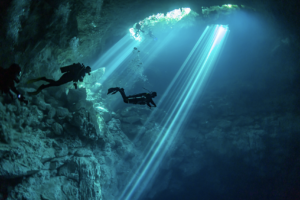The Yucatan Peninsula, with its breathtaking beauty and geological wonders, is renowned for one unique feature: cenotes. These enchanting underwater sinkholes, numbering in the thousands, punctuate the landscape and hold a mystique that has attracted explorers, divers, and scientists for decades. But have you ever wondered how cenotes were formed? Let’s dive into the fascinating geological processes that led to the creation of these underwater havens.
The story of cenotes begins millions of years ago when the Yucatan Peninsula was a massive coral reef submerged beneath the sea. Over time, as the sea levels dropped, the reef was exposed to the atmosphere. This exposed reef, largely composed of limestone, gradually formed the foundation of the Yucatan Peninsula.
Limestone is a porous rock that readily dissolves in slightly acidic water. Rainwater, mixed with carbon dioxide from the air and soil, creates a mild carbonic acid. This acid can slowly dissolve limestone over thousands of years, forming cracks and crevices that deepen and widen into underground channels and chambers filled with groundwater.
As these subterranean networks grow, they leave the limestone ceiling above them thin and susceptible to collapse. These collapses, whether gradual or sudden, result in the creation of cenotes – natural sinkholes open to the sky.
The cenotes of the Yucatan are linked to one another by an extensive network of underwater rivers, creating one of the largest subterranean aquatic systems on Earth. These channels continue to evolve and change, influenced by factors such as rainfall, temperature, and sea level.
Over thousands of years, dripping water inside these cave systems also results in the creation of breathtaking stalactites and stalagmites. These mineral formations decorate the interiors of cenotes, adding to their otherworldly charm and making each dive a unique exploration of natural artistry.
Understanding how cenotes were formed brings a deeper appreciation of these geological wonders. Their formation story speaks of nature’s persistent creativity and the slow, enduring artistry of water and rock. As we descend into a cenote, we are not just embarking on an underwater adventure; we’re journeying through time, witnessing the natural history of the Yucatan etched in every rock formation and underwater passage.


